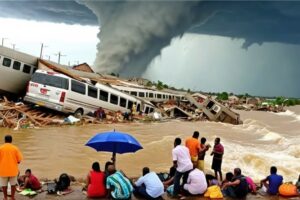
10 Destructive Natural Disasters Caught on Camera
SUBSCRIBE: https://bit.ly/3obsVlo
► Music Licensed From SoundStripe/Envato Elements
For any and all copyright matters, please email me directly at UnderworldCopyright@gmail.com
Unless otherwise created by Underworld, licenses have been obtained for images/footage in the video from the following sources; https://pastebin.com/w3TAntts
Underworld is creating the best new educational videos about the lesser known stories from around the world. We post Top 5’s, Top 10’s, Caught on Camera and much more! Be sure to SUBSCRIBE to never miss an upload!
source







There's no such thing as a natural event causing "collateral damage" — collateral damage can only be a result of a human or animal activity
😂😂 learn to stop building your cities in earthquake prone areas…landslide prone areas….volcano prone areas…wildfire prone… areas…. tornado prone areas and hurricane prone areas. oh..right…humans are not that smart….almost gave them too much credit, didn't I….
Story # 2- 3:36 in looks like king Kong to the right of the screen. I think it's a bush 🤷♂️
40 whole MPH? 😂
For those who didn't know typhoon Mangkhut qas in 2018 and typhoon Lekima was in 2019 and yes they're both got retired for causing massive damage. And also typhoon Mangkhut was a Cat 5 with winds between 160-180mph while Lekima was a high end Cat 4 with winds of 130-155mph.
I saw the earthquake in new jersey between Philadelphia pa an New York City for 3 weeks ago on the news but it’s little bit shaky no one was hurt. It’s looks like the continental drift of Pangea of plate tectonic of 🦖🦣 dinosaurs and prehistoric fossils from paleontology and geology of science.
Can you make video of 10 past history an caught video of earthquakes is included:
Earthquakes in new jersey in 2024
Earthquakes in los Angeles in 1971-1994
Earthquake In Alaska 1964
Earthquake in Japan in 2011
Earthquakes in San Francisco 1989
Earthquake in 1906.
Earthquake in Haiti in 2010
Bonus in earthquake back in Japan for January-1-2024 an earthquake Taiwan pass last week ago.
Absolutely enchanted by the magic of this video
Wow 😮
You can also include the town of Lytton, British Columbia, Canada. The heatwave back in 2021 reached 49.6 degrees Celcius, the highest temperature broken in Canada. The town burnt down and many had to evacuate.
why am i not on the list
Imagine that was your house 💀☠️💀☠️ 4:32
There are Very Few Truely Natural Disasters around the World Now aday's we did some ~ thing Weather it was10 , 50 , 100 Year's ago or more WE DID SOME ~ THING ;
👍
Dates, always dates, please
Great Videos
You lie !! China NEVER looks after its people. When these disasters happen in china, the people get no help from their government. 😡😠
Many parts of coastal Indonesia eliminated the mangroves to create more shrimp farms. That's why the tsunami in 2004 was so much worse than it should have been.
That's a tough bridge…lol
That tornado in Indonesia is close to my house NGL ,the wind is quite strong here😵
@8:52 This guy is the most unbelievable disaster, ever! Joe annihilated trillions of dollars of middle class wealth, with his destructive policies.
12:58 talks about a city near the capital Beijing….. shows a video of Shanghai ! Its like you aren't even trying ….. not even just a little!
7:00 "the tornado which lasted for 20 minutes and hit wind speeds of 40 mph"…….?!
Bruhh
Where's Budda now . Almighty
father and Jesus rules for😊ever.
Chinese infrastructures lousy
Roads slide off mtns all the time only in california do they make action vidieos of little slides that aint squat
Thanks for the visions….great site!
Pretty good 👍👍👍 thanks 👍👍
Number 7 : In modern history this was the first tornado in Indonesia
WOW
Jr volcanologist here ask me questions about super volcanos
How can you prepare for a tornado??
Ommmgggg that cop needs to back up
Well anyonw with any common sense wouldve never built that house so close to a canal anyways cause water obviously erodes canal banks which in tirn would cause the house to fall in anyways just like people build n flood plains its like how stupid can u be just a fleck of common sense tells u maybe i shpuldnt build there my house might flood or fall over der der derrrrrrr and im one dumbass mfer to my ignorant ass would know not to build shit by a canal but what do i know ima stupid dumbass mfer
Wow😮😮
10 facts about natural disasters:
Frequency and Distribution: Natural disasters occur worldwide, but their frequency and severity vary depending on geographical location and local environmental conditions.
Types of Natural Disasters: Natural disasters include earthquakes, hurricanes, tornadoes, floods, tsunamis, wildfires, volcanic eruptions, landslides, droughts, and avalanches.
Impact on Human Life: Natural disasters can cause significant loss of life and injuries, as well as widespread displacement of populations. They can also lead to long-term economic and social consequences for affected communities.
Mitigation and Preparedness: Preparedness and mitigation efforts, such as early warning systems, evacuation plans, building codes, and disaster relief programs, can help reduce the impact of natural disasters and save lives.
Climate Change Influence: Climate change is exacerbating the frequency and intensity of some natural disasters, such as hurricanes and wildfires, due to factors like rising temperatures, changing precipitation patterns, and sea-level rise.
Technological Advancements: Advances in technology, including remote sensing, computer modeling, and communication systems, have improved our ability to monitor, predict, and respond to natural disasters more effectively.
Economic Costs: Natural disasters can have significant economic costs, including damage to infrastructure, disruption of businesses, loss of agricultural productivity, and increased insurance premiums.
Social Vulnerability: Certain groups, such as the elderly, children, people with disabilities, and those living in poverty or in marginalized communities, are often more vulnerable to the impacts of natural disasters due to limited resources and access to support services.
Environmental Consequences: Natural disasters can have lasting environmental consequences, such as soil erosion, habitat destruction, contamination of water sources, and loss of biodiversity.
Global Cooperation: Given the global nature of many natural disasters, international cooperation and collaboration are essential for effective disaster response, recovery, and resilience-building efforts.
Mother Nature reclaims anything she wants to
1 Peter 4:7 The end of all things is near. Therefore be alert and of sober mind so that you may pray. Lord Jesus Christ is coming soon🙏🏼❤️🕊REPENT, believe in the Gospel, Be Born Again
Wow.. terrible moments that's for sure😯
0:14 The domino effect☠️🙏
Stop deforestation because them trees keeps the soil in check..
Ur the best YouTuber in history!!
E